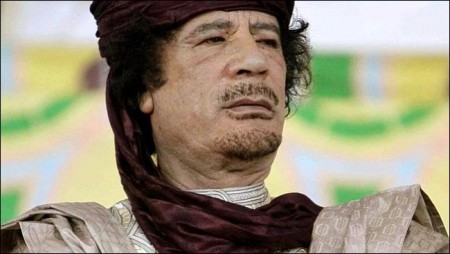Gaddafi was the youngest child from a nomadic Bedouin peasant family in the desert region of Sirte. He was given a traditional religious primary education and attended the Sebha preparatory school in Fezzan from 1956 to 1961. Gaddafi and a small group of friends that he met in this school went on to form the core leadership of a militant revolutionary group that would eventually seize control of the country of Libya. Qaddafi’s inspiration was Gamal Abdul Nasser, a popular statesman in neighboring Egypt who rose to the presidency by appealing to Arab unity and condemning the West. In 1961, Qaddafi was expelled from Sebha for his political activism.
He went on to attend the University of Libya, where he graduated with high grades. He then entered the Military Academy in Benghazi in 1963, where he and a few of his fellow militants organized a secretive group dedicated to overthrowing the pro-Western Libyan monarchy. After graduating in 1965, he was sent to Britain for further training, returning in 1966 as a commissioned officer in the Signal Corps.
Rise to power
On September 1, 1969, Colonel Gaddafi and his secret corps of Unionist Officers staged a bloodless, unopposed coup d’état in Tripoli, the capital, while the elderly King Idris I was on a visit to Turkey. Immediately afterward there was a short power struggle between Qaddafi and his young officers on one side and older senior officers and civilians on the other, and Qaddafi assumed power in January 1970. He named the country the Libyan Arab Republic and ruled as president of the Revolutionary Command Council from 1969 to 1977, then switched to the title of president of People’s General Congress from 1977 to 1979. In 1979 he renounced all official titles but remained the de facto ruler of Libya.
Islamic Socialism and Pan Arabism
Gaddafi based his new regime on a blend of Arab nationalism, aspects of the welfare state and what Qaddafi termed “direct, popular democracy.” He called this system “Islamic socialism” and while he permitted private control over small companies, the government controlled the larger ones. Welfare, liberation and education were emphasized. He also imposed a system of conservative morals, outlawing alcohol and gambling. To reinforce the ideals of this socialist state, Qaddafi outlined his political philosophy in his Green Book, published in 1976. In practice, however, Libya’s political system is thought to be somewhat less idealistic and from time to time Qaddafi has responded to domestic and external opposition with violence. His revolutionary committees called for the assassination of Libyan dissidents living abroad in February 1980, with Libyan hit squads sent abroad to murder them.
With respect to Libya’s neighbors, Gaddafi followed Abdul Nasser’s ideas of pan-Arabism and became a fervent advocate of the unity of all Arab states into one Arab nation. He also supported pan-Islamism, the notion of a loose union of all Islamic countries and peoples. After Nasser’s death on September 28 1970, Qaddafi attempted to take up the mantle of ideological leader of Arab nationalism. He proclaimed the “Federation of Arab Republics” (Libya, Egypt and Syria) in 1972, hoping to create a pan-Arab state, but the three countries disagreed on the specific terms of the merger. In 1974 he signed an agreement with Tunisia’s Habib Bourguiba on a merger between the two countries, but this also failed to work in practice and ultimately differences between the two countries would deteriorate into strong animosity.
Views: 432



